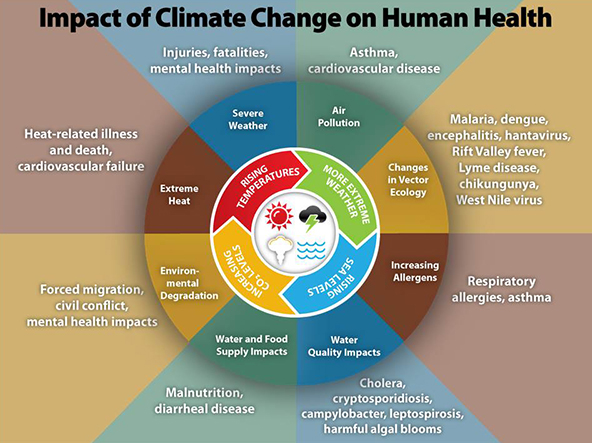This post was authored by HEFN Director Karla Fortunato. It originally appeared on Health Affairs Blog’s GrantWatch section, June 17, 2015.
From 1600 Pennsylvania Avenue to Vatican City, global leaders are acknowledging the threat of climate change to people around the world.
This recognition has come to philanthropy as well. Foundations are finding compelling motives and innovative areas for making grants linking climate and health. Grantmakers focused on communities, public health, and health disparities are addressing climate change to achieve critical goals like population protection, disease prevention, and community transformation.
While this philanthropic activity is nascent, the opportunities to have an impact are substantial. In the words of Maria Neira of the World Health Organization (WHO), “Since 2007 I have described climate change as the defining issue for public health in this century. Today, I would add that it is one of the greatest opportunities we face to improve human health.”
Grant making at the intersections of climate and health extends beyond environmental action into areas like emergency preparedness, the U.S. public health infrastructure, and transitions to healthier forms of energy, transportation, land use, and community economic development.
A recent publication on Achieving a Climate for Health: Philanthropy to Promote Health and Justice through the Challenges of Climate Change, jointly published by the Health and Environmental Funders Network (HEFN) and ecoAmerica, outlines these opportunities with examples of philanthropic engagement.
Protect People
Our climate system is warming, and this causes changes to systems that are critical to health, like air quality, weather, water quality, and agriculture. Scientific consensus on the projected effects of the changing climate is fueling plans to help communities navigate and mitigate these impacts: from bolstering public health infrastructure, to mapping vulnerable populations (like seniors and people with disabilities), to developing town and city evacuation plans, to improving hospitals’ ability to withstand weather events.
An early US investor on this front is the Centers for Disease Control and Prevention (CDC). Its Climate-Ready States & Cities Initiative and Building Resilience Against Climate Effects (BRACE) framework are helping sixteen states and two cities prepare for upcoming impacts of climate change.
Foundations are engaging in people-protection as well. In Boston, the Barr Foundation, the Boston Foundation, the Chorus Foundation, the Grantham Foundation, the Henry P. Kendall Foundation, the Bank of America Foundation, and the Ruth Lilly Philanthropic Foundation have supported a Green Ribbon Commission, aimed at bringing business and other key leaders together to inform climate change strategies for the city. In southern California, the California Endowment and San Diego Foundation are working with regional leaders to focus preparedness and health-protective action in communities of high need, such as low-income communities or those projected to be harder hit by the effects of climate change.
The Kresge Foundation is focusing on vulnerable populations in urban communities in the United States through a new climate initiative to bolster the voices and influence of low-income urban groups in climate change planning and policies.
Prevention
Alongside population protection, philanthropy also is investing to reduce the intensity of climate change’s effects—reducing or preventing disease and reducing the intensity and frequency of weather-related disasters. The Kresge Foundation and Robert Wood Johnson Foundation funded a project exploring different public health scenarios, noting that government actions on climate change in the next few years could yield very different public health outcomes. There’s an important opening now to prevent long-term harm by mitigating the extent of these climate change impacts.
Funders are tackling this work in a number of ways. The New York Community Trust is building a research base for health engagement in policy making through its support of Columbia University’s Mothers and Newborns study, which improves understanding of the impacts of air pollution on healthy childhood development.
Other funders are supporting groups like the American Public Health Association (APHA), American Lung Association, the Public Health Institute, the National Medical Association, and Health Care Without Harm to amplify health and public health engagement in climate policies.
Others are working directly to reduce use of highly polluting energy. The Energy Foundation’s American Clean Energy Stories highlight both climate and economic gains made through energy efficiency projects.
Transformation of Communities
A National Research Council study of the hidden costs of energy found $120 billion in damages, mostly health damages, were being passed on to the American public in 2005 from fossil fuel energy. The fact that climate change drivers in energy, transportation, and agriculture have such big health impacts creates an opportunity for collaboration across philanthropic sectors—health, environment, equity, climate and energy, smart growth, sustainable agriculture, economic development—to work toward health-enhancing community transformations.
What does this look like? The Liberty Hill Foundation helped academic and community partners identify Los Angeles neighborhoods disproportionately burdened by pollution, and then it funded efforts to “clean up and green up” local businesses, which improved both air quality and job opportunities. Targeting climate action—such as reducing greenhouse gas emissions—to overburdened areas, in fact, is now required by California’s climate laws.
In the Appalachia region of the United States, which has a long history of extracting energy from the land, the New World Foundation, Chorus Foundation, New York Community Trust, Blue Moon Fund, and Energy Foundation have funded groups to extend community organizing efforts into advocacy for cleaner energy, healthier jobs, and regional economic opportunity.
National dialogues across philanthropic portfolios also are planned. The September 2015 Environmental Grantmakers Association retreat agenda includes discussion of partnership opportunities between health and environmental grantmakers.
Conclusion
While climate change has long been the bailiwick of environmentalists, the impacts of climate change are hitting every sector and every community. Grantmakers with health as a funding priority are beginning to engage in preparedness, policy analysis, and advocacy efforts and are elevating health protection, equity, and healthy economic development in strategies to create a climate for health.

